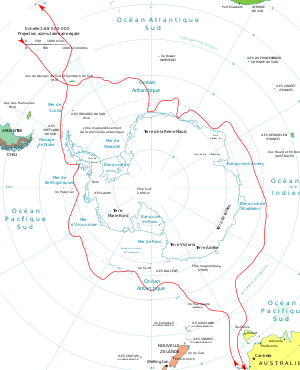
Back بعثة بيلنجشوزن Arabic Birinci Rus Antarktika ekspedisiyası Azerbaijani Першая руская антарктычная экспедыцыя Byelorussian Første russiske antarktisekspedition 1819-21 Danish Venemaa esimene Antarktika ekspeditsioon Estonian Expédition Bellingshausen French Orosz antarktiszi expedíció Hungarian Прва руска антарктичка експедиција Macedonian Первая русская антарктическая экспедиция Russian Перша російська антарктична експедиція Ukrainian
| First Russian Antarctic Expedition | |
|---|---|
 First Russian Antarctic Expedition route | |
| Type | Scientific expedition |
| Date | 1819 – 1821 |
| Executed by | Fabian Bellingshausen, Mikhail Lazarev. |
The First Russian Antarctic Expedition took place in 1819–1821 under the direction of Fabian Bellingshausen and Mikhail Lazarev. The expedition aimed to reach the Southern Ocean in order to prove or disprove the existence of a suspected seventh continent, Antarctica. The sloop Vostok was under the command of Bellingshausen, while Lazarev commanded the sloop Mirny. Overall, the crew consisted of 190 people.
Due to extreme haste in equipping the voyage (the order was released on March 15, and the departure took place on July 4, 1819), it was impossible to assemble a science team. Thus, almost all scientific observations in the fields of geography, ethnography, and natural history were conducted by officers and the only scientist on board, associate professor Ivan Mikhailovich Simonov, who taught at the Imperial Kazan University. A novice painter, Pavel Mikhailov, was hired to depict the events, landscapes, and biological species encountered during the expedition. His paintings of the South Shetland Islands were used in English sailing directions until the 1940s.[1]
The Russian Antarctic expedition ended in complete success and became the second expedition to circumnavigate Antarctica after James Cook's expedition a half century earlier. Of the expedition's 751 days, 527 were spent at sea; the overall length of the route was 49,860 nautical miles.[2] For 127 days the expedition was above 60° south latitude; the crew approached the Antarctic shore nine times, four times as close as 13–15 kilometres (8.1–9.3 mi) from the continent. Around 28 objects were depicted on the map of Antarctica which emerged, and 29 islands in high southern latitudes and the tropics were discovered and named.[3][4]
The results of the expedition were published in Russian in 1831 in two volumes with the drawings applied in an atlas. In 1842, a short report was published in Germany. In 1945, a full English translation of Bellingshausen's only book was edited by polar explorer Frank Debenham and released.
- ^ Беллинсгаузен 1949, pp. 28–29.
- ^ Беллинсгаузен 1949, p. 343.
- ^ Магидович 1985, p. 30.
- ^ Tammiksaar 2007, pp. 823–824.